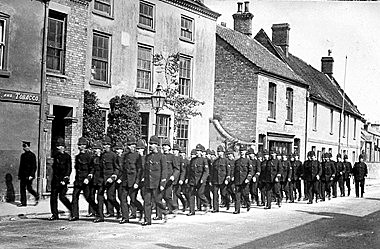
The bobby on the beat was a reassuring
sight in past times
by REX NEEDLE
|
There has been a police presence in Bourne for over 170 years to reassure the public that they are safe in their homes and on the street although the sight of a bobby on the beat is less familiar today than it was in the past. Until the early 19th century, maintaining law and order was difficult because crime, especially theft, was rampant and bands of miscreants roamed the countryside stealing whatever they could lay their hands on, usually food because poverty and hunger were widespread. Until the formation of an established police force, the maintenance of law and order was in the hands of parish constables appointed annually by the magistrates, usually farmers and yeomen who combined the duties with their normal work, but it was an inefficient system and riots and disturbances were not uncommon. When such events were anticipated, they called on a body of special constables who were recruited and sworn in from various walks of life provided they were of respectable character, such as labourers, shop keepers, clerks and tradesmen and this enabled the parish constable rally a large body of men to a given place at short notice and if the incident got out of hand, then they could call out the militia. But the system was in need of revision and the formation of a permanent police force began with the passing of the County Police Act in 1839. As a result, the first policeman for the parish of Bourne was appointed in 1843 and although there was much grumbling that he was being financed by the poor rate levied on property owners, the officer was soon being commended for keeping a strict watch on prowling vagrants. Further improvements were made with the County and Borough Police Act of 1856, bringing together the Lincolnshire divisions of Lindsey, Holland and Kesteven, which included Bourne, and a meeting of magistrates appointed the first chief constable, Captain Philip Bicknell, who was selected from 102 applicants. Although there was only one chief constable, each of the three divisions was to have its own police force but overall, it was known from the start as the Lincolnshire Constabulary. The Bourne contingent was in place by May 1857 when the Stamford Mercury reported: “This long looked for force arrived in Bourne last week and already a considerable improvement may be noticed. This was apparent on Monday last when the loiterers at the corners were much surprised at the order to ‘move on’ which they also found would be to their advantage promptly to obey. No less than six or eight cases of petty larcenies have occurred and parties have been apprehended upon suspicion. The town itself is supplied with one superintending officer and two men.” In fact, the police presence appears to have had its effect in many areas, notably the annual May Statute Fair which was held a few days later, an occasion normally marred by drunkenness and fighting and frequented by tricksters and pickpockets. But the newspaper reported: "We are glad to notice a decided improvement in the manners and appearance of those who attended. Not a single case of disorderly conduct took place that required the interference of the police who were very alert all day." The population of Bourne was then 3,720 (1851 census figure) but the police strength increased as the town expanded and by 1861 a permanent police headquarters had been established at the corner of Burghley Street and North Street complete with offices, cells and hostel accommodation for the constables so enabling them to be on 24-hour call. There were then 16 officers but this had increased to 19 by 1875 and the coming of a regular police force brought a considerable decrease in crime and general lawlessness. Policemen on foot patrol day and night were a familiar and comforting sight and during the early years of the 20th century when the motor car was becoming popular, uniformed officers could be seen regularly on point duty to keep traffic moving in the increasingly busy town centre, especially on market days but when the first traffic lights were introduced in 1973, they were no longer necessary and so began the reduction in the police presence on the streets. The police station in North Street continued in use until 1960 when it was replaced by a new building in West Street while the old premises were demolished to make way for a block of maisonettes for the elderly. The new facility, however, was downgraded to office status in 2000 and open only five days a week with an indeterminate staffing level for duties in the town. Yet by 2014, Lincolnshire Police had 1,100 sworn officers, 149 community support officers, a new breed of police men and women although with limited powers, 415 civilian support staff with 232 special constables, 80 police volunteers and 118 cadets and an annual spending budget of £114 million. These grand statistics are paraded to persuade the public that they are fully protected but not everyone in Bourne feels any safer than they did in 1843 when there was just one officer on the beat. In the past 170 years, modern policing methods have changed dramatically through the introduction of mobile patrols, new technology, shorter working hours and fewer points of personal contact with the result that the television image of Dixon of Dock Green as the friendly neighbourhood constable has all but disappeared. There is undoubtedly increased efficiency but public concern persists, particularly among the elderly who feel uneasy when petty crime frequently goes unchecked and their environment is threatened by litter, graffiti, vandalism and other anti-social behaviour. As a result, there is a frequent cry for a permanent return of the constable on the beat who was such a reassuring sight in past times but the indications are that this is unlikely to happen. |